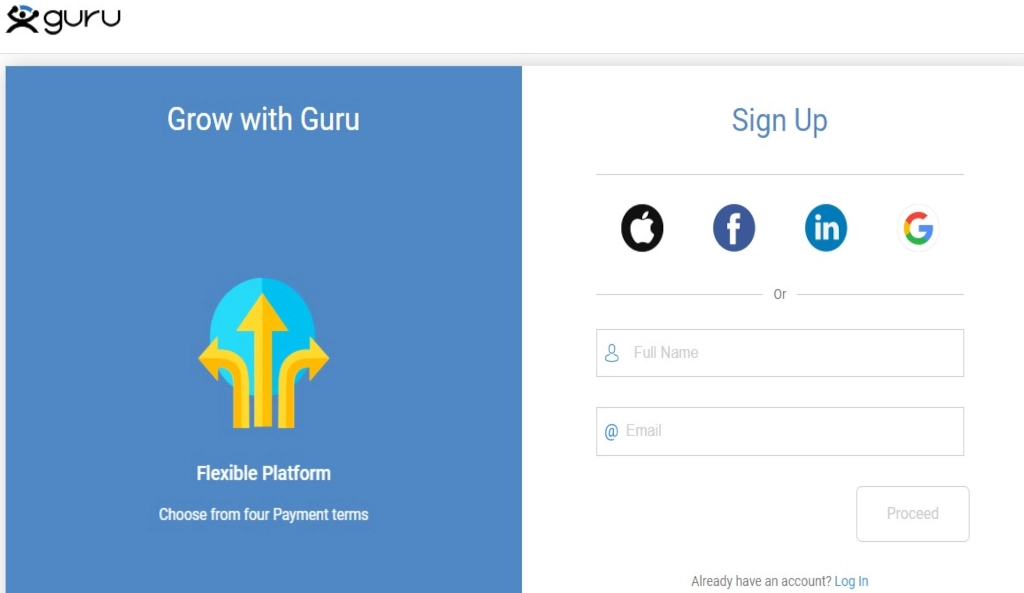Welcome to the world of freelancing with Guru! In this guide, we’ll explore the vibrant online freelancing landscape, highlighting Guru, a leading platform that connects freelancers with clients worldwide. Let’s dive in and discover what is Guru and unlock the potential of this powerful platform together!
What is Guru?
Guru is an established online freelancing platform that has been around since 1998, making it one of the older and more experienced players in the freelance marketplace. The platform simplifies the process of finding and hiring freelancers while helping freelancers find meaningful work opportunities.
The platform allows freelancers to create comprehensive profiles that highlight their expertise, experience, and past work. Clients can browse these profiles or post specific job listings, which freelancers can then bid on by submitting proposals. Guru’s system promotes transparency and trust by allowing users to leave feedback and ratings after each project, helping both freelancers and clients build credible reputations.
Yogapedia explains Guru
A “guru” is a revered teacher or mentor who guides students on their spiritual and physical journey. The term “guru” comes from Sanskrit, meaning “dispeller of darkness,” highlighting the role of the guru in providing enlightenment and knowledge.
Guru Creates a dynamic platform designed to bridge the gap between freelancers and clients. It simplifies the process of finding and offering freelance services by providing:
- A User-Friendly Marketplace: creates a space where freelancers can showcase their skills and clients can post job opportunities.
- Streamlined Hiring Process: The platform creates a seamless workflow for job posting, bidding, and hiring, making it easy for both parties to connect and collaborate.
- Secure Payment System: With features like SafePay, for Guru to create a secure environment ensuring freelancers get paid fairly and clients receive quality work.
- Efficient Communication Tools: Guru creates tools for effective communication and project management, facilitating smooth interactions between freelancers and clients.
History of Guru: From Inception to Present Day
Guru was founded in 1998 by Inder Guglani as a platform for freelancers to connect with clients. Here’s a brief history of Guru:
Early Years
- 1998: Guru was launched as a pioneering platform in the freelance marketplace space. It aimed to create a space where freelancers and businesses could collaborate effectively.
Growth and Development
- 2000s: Throughout the early 2000s, Guru continued to grow, expanding its features and improving its platform to better serve both freelancers and clients. It introduced key features like the SafePay system and WorkRoom for project management.
Key Milestones
- 2009: Guru made significant updates to its interface and functionality, enhancing user experience and expanding its global reach.
- 2013: The platform rebranded to focus more on the freelance economy and introduced a range of membership plans to cater to different needs.
Recent Developments
- 2015 and Beyond: Guru continued to evolve with updates to its technology and features, including improved tools for communication and project management. It aimed to stay competitive in the growing freelance market by refining its service offerings and user experience.
Present Day
- 2020s: Guru remains a prominent player in the freelance marketplace, offering a variety of tools and subscription plans to support both freelancers and clients. It focuses on maintaining a secure and efficient platform for remote work and collaboration.
How does Guru work?

1. Sign Up and Profile Creation

- Freelancers: Freelancers start by signing up for an account on Guru. They create a profile showcasing their skills, experience, and portfolio. This profile acts as their resume, helping clients understand what they can offer.
- Clients: Clients also sign up and create a profile. They describe their business and the type of projects they need help with.
2. Finding Work or Freelancers
- Job Posting: Clients post jobs or projects they need help with, detailing the scope, budget, and deadlines. They can search for freelancers who match the skills they need.
- Job Search: Freelancers can browse through posted jobs and apply to those that match their skills. They can also set up alerts to get notified of jobs that fit their expertise.
3. Bidding and Proposals
- Bidding: Freelancers submit proposals to clients, outlining how they plan to complete the job, their timeline, and their rates. Clients can review these proposals and choose the freelancer that best fits their needs.
- Negotiation: Sometimes, clients and freelancers negotiate terms before finalizing the contract. This might include adjusting the budget, timeline, or specific project details.
4. Hiring and Agreements
- Agreement: Once a client selects a freelancer, they both agree on the terms of the project, including deadlines, deliverables, and payment schedules. Guru offers a WorkRoom feature where both parties can collaborate, share files, and communicate securely.
- Payment Terms: Clients can choose to pay freelancers on an hourly basis, per milestone, or upon project completion. Guru offers SafePay, an escrow service that holds the funds until the work is completed to the client’s satisfaction.
5. Project Execution
- Work in Progress: The freelancer begins working on the project as per the agreed terms. They can share updates, request feedback, and communicate with the client through the WorkRoom.
- Milestones: For larger projects, work might be divided into milestones. The freelancer submits work at each milestone, and the client approves it before moving on to the next stage.
6. Payment and Review
- Payment Release: Once the work is completed and approved, the client releases the payment held in SafePay. The funds are then transferred to the freelancer’s account.
- Feedback and Rating: After the project is completed, both the client and freelancer can leave feedback and rate each other. This helps build reputation and trust on the platform.
7. Dispute Resolution
- Disputes: If there are any disagreements during the project, Guru provides a dispute resolution service. Both parties can present their case, and Guru will help mediate a solution.
- Arbitration: In cases where disputes can’t be resolved through mediation, Guru offers arbitration services where an independent arbitrator makes a binding decision.
8. Long-Term Relationships
- Ongoing Work: Many clients and freelancers continue working together on multiple projects after establishing a good working relationship. Guru facilitates this by allowing easy contract renewal or new job postings for existing freelancers.
9. Fees and Membership
- Platform Fees: Guru charges a service fee on payments processed through the platform, which is deducted from the freelancer’s earnings. The fee varies based on the freelancer’s membership plan and the total amount of business they do on the platform.
- Membership Plans: Freelancers can choose from different membership plans, offering various benefits like reduced fees, increased visibility, and more bids.
Guru’s Freemium Subscription Plan: Features and Limitations
Guru offers a Freemium subscription Model. This allows freelancers to join the platform and use basic features without paying any upfront subscription fees. However, there are some limitations compared to the paid membership plans.
Know more about the subscription business model
What the Freemium Plan Includes:
- Basic Profile Visibility: Your profile is visible on the platform, but not as prominently as those with paid plans.
- Limited Bids: You have a limited number of bids per month to apply for jobs. If you run out, you’ll need to wait until the next month or purchase additional bids.
- Access to WorkRooms: You can use WorkRooms to manage your projects, communicate with clients, and share files.
- SafePay: You still have access to Guru’s SafePay system for secure payments.
Limitations of the Freemium Plan:
- Higher Fees: Guru typically charges a higher service fee on earnings for freelancers using the Freemium plan.
- Lower Visibility: Your proposals and profile might be less visible to clients compared to those on paid plans.
- Fewer Features: Advanced features like increased bids, priority support, or enhanced profile customization are reserved for paid plans.
Benefits of Using Guru
- Wide Range of Freelancers: Guru offers access to a diverse pool of freelancers across various categories, making it easy to find talent for almost any type of project.
- Secure Payment System: Guru’s SafePay system ensures secure transactions by holding funds in escrow until the work is completed to the client’s satisfaction.
- Flexible Hiring Options: Clients can choose from different hiring models, such as hourly, per milestone, or fixed-price contracts, providing flexibility in managing project costs.
- Collaboration Tools: The WorkRoom feature allows clients and freelancers to collaborate efficiently, share files, track progress, and communicate in one place.
- Customizable Profiles: Freelancers can showcase their skills, experience, and portfolios through customizable profiles, helping them attract potential clients.
- Dispute Resolution: Guru offers mediation and arbitration services to help resolve any conflicts that might arise between clients and freelancers.
- Global Reach: With users from around the world, Guru provides opportunities for freelancers to work with clients globally and for clients to access a broad talent pool.
- Freemium Access: Freelancers can join and use the platform for free, with the option to upgrade for additional features and lower fees.
Challenges of Using Guru
- Service Fees: Guru charges service fees on earnings, which can be relatively high, especially for freelancers on the Freemium plan. This might impact overall earnings.
- Competition: With a large number of freelancers on the platform, standing out and winning projects can be challenging, particularly for newcomers.
- Limited Free Features: The Freemium plan has limitations, such as fewer bids and higher service fees, which may require freelancers to upgrade to a paid plan for more benefits.
- Quality Control: While Guru has many talented freelancers, clients might encounter varying levels of quality and professionalism, which can be mitigated by thoroughly vetting candidates.
- Dispute Resolution Process: Although Guru provides dispute resolution services, the process can sometimes be slow or complex, leading to frustration for both parties.
- Platform Fees for Clients: Clients also face platform fees, which can add to the overall project cost and might be a consideration when budgeting.
- Learning Curve: New users might need time to become familiar with Guru’s features and best practices for finding and managing freelancers or projects.
Payment and Fees on Guru
Payment Process for Freelancers:
Freelancers receive payments through Guru’s platform, which offers several options to ensure smooth transactions. Once a job is completed and approved by the client, the freelancer submits an invoice. Payments are typically processed through Guru’s payment system, and freelancers can choose to receive their funds via direct bank transfer, PayPal, or other available methods.
Learn more about PayPal; how does PayPal work
Guru’s Fee Structure:
Guru charges fees for both freelancers and clients. Freelancers pay a service fee based on their membership level:
- Basic Membership: Includes a standard fee for each job or transaction.
- Paid Memberships: Offer reduced fees or additional features, such as priority support and more bids per month.
Clients do not pay a direct fee to post jobs. However, Guru may charge service fees or transaction fees depending on the payment method and job contract details.
Payment Protection and SafePay Feature:
Guru’s “SafePay” feature is designed to protect both freelancers and clients throughout the payment process. It ensures that:
- For Freelancers: Funds are securely held until the work is approved, reducing the risk of non-payment.
- For Clients: Payment is only released once the freelancer meets the project requirements, ensuring quality and satisfaction.
Types of Services Offered by Guru
Guru hosts a wide range of freelance services, categorized to help clients easily find the right talent. Some of the main categories include:
Writing & Translation
- Content Writing
- Copywriting
- Technical Writing
- Translation Services
- Editing & Proofreading
Graphic Design & Multimedia
- Logo Design
- Illustration
- Video Production
- Animation
- Photography
Programming & Development
- Web Development
- Mobile App Development
- Software Development
- E-commerce Development
- Game Development
Digital Marketing
- SEO (Search Engine Optimization)
- Social Media Marketing
- Email Marketing
- PPC (Pay-Per-Click) Advertising
- Content Marketing
Business & Finance
- Accounting & Bookkeeping
- Financial Analysis
- Business Consulting
- Market Research
- Virtual Assistance
Sales & Marketing
- Lead Generation
- Sales Strategy
- Telemarketing
- Public Relations
- Brand Management
Engineering & Architecture
- CAD Design
- Civil Engineering
- Mechanical Engineering
- Architecture
- Structural Engineering
Legal Services
- Contract Drafting
- Legal Consulting
- Intellectual Property
- Corporate Law
- Legal Research
Administrative Support
- Data Entry
- Virtual Assistance
- Customer Support
- Project Management
- Transcription
Education & Training
- Online Tutoring
- Curriculum Development
- Educational Consulting
- E-learning Development
- Coaching & Mentoring
You may like to read; how does outschool works
Popular Industries and Skills in Demand:
Certain industries and skills are particularly in demand for Guru, reflecting broader trends in the freelance market:
- Technology & IT: Web and mobile development, software engineering, and cybersecurity are highly sought after due to the growing need for digital solutions.
- Digital Marketing: With the rise of online business, skills in SEO, social media marketing, and content creation are consistently in demand.
Know more about SEO: how does SEO work
Comparison with Other Freelance Platforms
| Feature | Guru | Upwork | Fiverr | Freelancer |
|---|---|---|---|---|
| Fee Structure | Service fees are from 10% to 20%, and there are multiple membership plans. | Service fees range from 5% to 20%; various membership plans. | Fees on services start at 20%; no membership fees. | Service fees from 10% to 20%; multiple membership plans. |
| Sign-Up Process | Simple account creation for both freelancers and clients. | Requires profile completion and verification. | Quick sign-up with profile and gig creation. | Simple registration; profile and project listing required. |
| Job Posting and Bidding | Clients post jobs; freelancers bid and submit proposals. | Clients post jobs; freelancers submit proposals or bids. | Freelancers create gigs; clients browse and purchase. | Clients post projects; freelancers bid or accept invitations. |
| Unique Selling Points | SafePay payment protection; flexible membership options. | Large global user base; diverse job categories. | Quick gig creation; fixed-price services. | Wide range of project types; competitive bidding. |
| Workflow and Communication Tools | Integrated messaging, file sharing, and work management tools. | Messaging, time tracking, and collaboration tools. | Messaging and limited project management features. | Messaging, milestone tracking, and project management tools. |
Read more about other freelancing platforms; Upwork and Fiver: how does Fiver work
Future Trends and Updates on Guru
Recent Updates or Planned Features:
- Enhanced AI Matching: Guru is working on improving its AI algorithms to better match freelancers with suitable projects based on skills and past performance.
- New Payment Options: Guru plans to expand its payment options to include more digital wallets and cryptocurrencies to cater to a global audience.
- Upgraded Mobile App: Updates to the Guru mobile app will include more robust features for managing projects and communication on the go.
- Improved Reporting Tools: Guru aims to introduce more detailed reporting and analytics tools to help freelancers and clients track performance and project success.
Trends in Freelancing and How Guru is Adapting:
- Remote Work Surge: With the increase in remote work, Guru is enhancing its platform to support fully remote project management and communication tools.
- Specialized Skill Demand: As demand for specialized skills grows, Guru is focusing on adding more niche categories and promoting freelancers with unique expertise.
- Integration with Collaboration Tools: Guru is integrating with popular collaboration and productivity tools to streamline workflows and enhance project management.
- Global Expansion: To tap into new markets, Guru is expanding its services and language support to accommodate a more diverse, international user base.
Want to Build Your Own App Like Guru?
Are you planning to develop your own app like Guru? Visit Nlance Which allows you to develop your own platform similar to Upwork. Get advice from our experienced team building award-winning app development services and scaling successful startups and businesses for over 20 years. Contact us today for a free quote on your app development project.


angle shown of money making from such a platform is nice to know.
henry ford did not invent the 40 hour work week. thats just dumb. at best he was forced by lanor unions to submit to it. entrepraneur my bung hole.